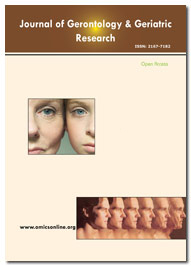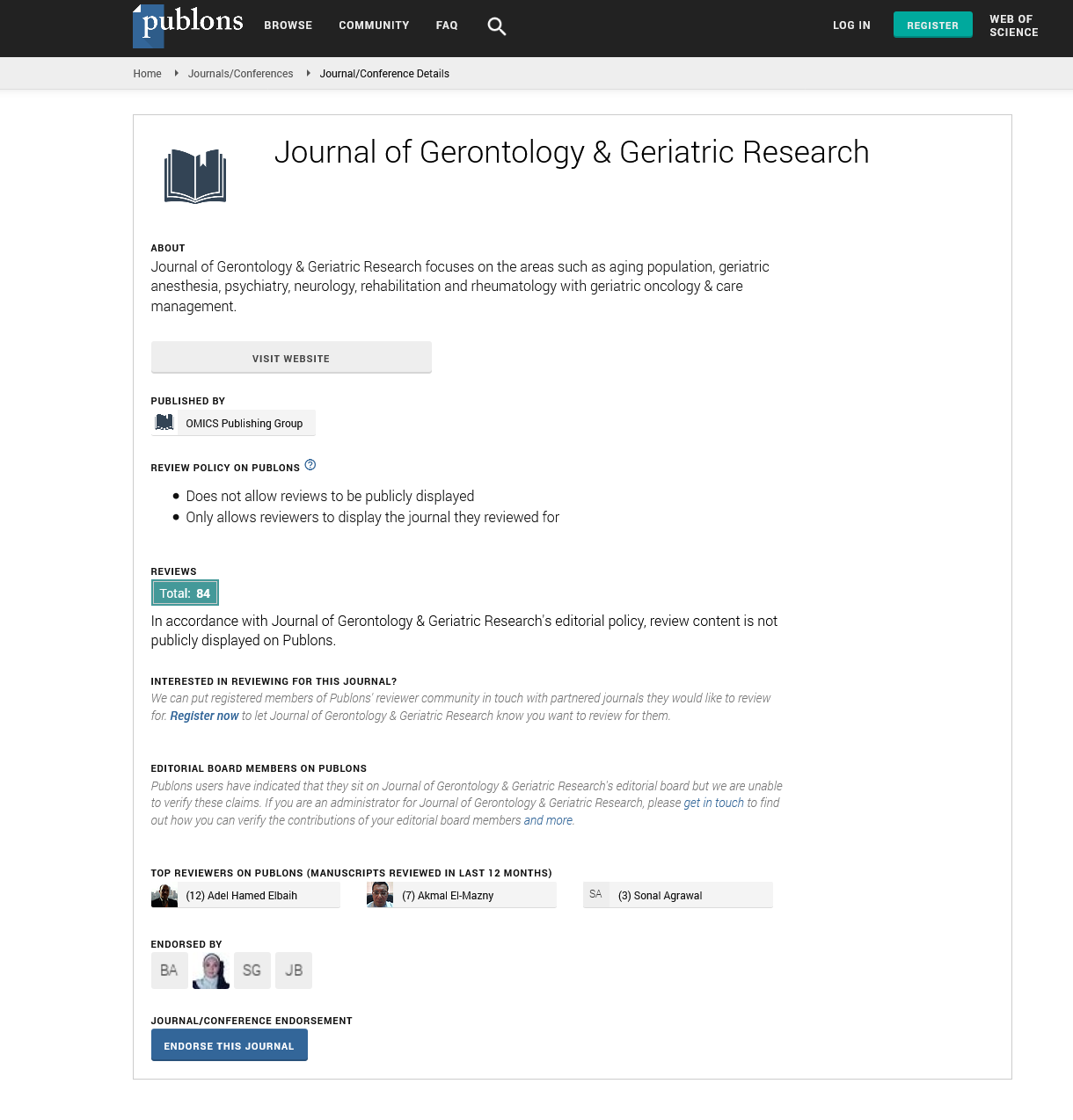Indexed In
- Open J Gate
- Genamics JournalSeek
- SafetyLit
- RefSeek
- Hamdard University
- EBSCO A-Z
- OCLC- WorldCat
- Publons
- Geneva Foundation for Medical Education and Research
- Euro Pub
- Google Scholar
Useful Links
Share This Page
Journal Flyer

Open Access Journals
- Agri and Aquaculture
- Biochemistry
- Bioinformatics & Systems Biology
- Business & Management
- Chemistry
- Clinical Sciences
- Engineering
- Food & Nutrition
- General Science
- Genetics & Molecular Biology
- Immunology & Microbiology
- Medical Sciences
- Neuroscience & Psychology
- Nursing & Health Care
- Pharmaceutical Sciences
Opinion - (2024) Volume 13, Issue 4
The Intersection of Genetics and Aging: Uncovering New Pathways for Age-Related Diseases
Pemul Kontansitte*Received: 03-Aug-2024, Manuscript No. jggr-24-27616; Editor assigned: 05-Aug-2024, Pre QC No. P-27616; Reviewed: 17-Aug-2024, QC No. Q-27616; Revised: 23-Aug-2024, Manuscript No. R-27616; Published: 30-Aug-2024, DOI: 10.35248/2167-7182.2024.13.749
Introduction
Aging is a complex, multifactorial process that has fascinated scientists for centuries. As the global population continues to age, understanding the biological mechanisms behind aging becomes increasingly critical—not only for enhancing the quality of life but also for combating the rise of age-related diseases. From Alzheimer's disease to cardiovascular conditions, aging is linked to a wide array of disorders that impact millions of individuals worldwide. Recently, researchers have begun to explore how genetics plays a pivotal role in the aging process and in the onset of age-related diseases [1]. By decoding the genetic underpinnings of aging, scientists hope to uncover novel therapeutic targets, delay the onset of age-associated diseases, and potentially extend human lifespan. This intersection between genetics and aging represents a rapidly growing field of study that holds promise for revolutionary breakthroughs in medicine.
Description
The aging process is influenced by a variety of factors, including environmental influences, lifestyle choices, and genetics. While lifestyle interventions such as diet and exercise can certainly slow the progression of aging, genetic factors play a significant role in determining both the rate of aging and susceptibility to age-related diseases. In recent years, advances in genomics, including the mapping of the human genome, have provided new insights into how specific genes and genetic pathways contribute to aging and disease. At the heart of these discoveries are key genetic pathways that govern cellular processes such as DNA repair, protein homeostasis, and cellular senescence. For instance, genes involved in DNA repair, like those in the sirtuin family, have been linked to longer lifespan and improved health in aging populations. Similarly, the role of telomeres—protective caps on chromosomes that shorten as we age—has been extensively studied for its connection to cellular aging and the development of age-related diseases like cancer [2]. Research has also uncovered how inflammation, often referred to as "inflammaging," is controlled by genetic factors, driving the progression of diseases like arthritis, cardiovascular disease, and neurodegenerative disorders.
Beyond individual genes, scientists are also studying how genetic interactions within larger biological networks affect aging. One such network is the mTOR pathway, which regulates cellular growth and metabolism. Inhibition of mTOR has been shown to extend lifespan in a variety of organisms, including mice, by enhancing autophagy—the body’s mechanism for cleaning out damaged cells and recycling cellular components. The mTOR pathway is thought to play a significant role in age-related diseases, including cancer, diabetes, and neurodegeneration. By understanding the genetic regulation of these networks, researchers may be able to develop drugs that mimic the effects of caloric restriction or autophagy enhancement, both of which have been associated with increased longevity and reduced risk of age-related diseases. Additionally, the field of epigenetics—how external factors influence gene expression without altering the DNA sequence—has brought a new layer of complexity to aging research [3]. Epigenetic changes accumulate as we age and can influence how genes are turned on or off, which in turn affects cell function and tissue health. For example, epigenetic modifications to genes involved in inflammation and immune function may increase the risk of age-related conditions like autoimmune diseases or cardiovascular diseases. The good news is that some of these epigenetic changes may be reversible, offering another potential therapeutic avenue. By targeting the epigenome, scientists may be able to develop interventions that "reset" gene expression to a more youthful state, potentially reversing some aspects of aging and improving healthspan [4,5].
Conclusion
The intersection of genetics and aging has the potential to revolutionize our approach to age-related diseases and aging itself. By identifying the specific genes and molecular pathways that contribute to aging and its associated diseases, we are on the cusp of developing personalized therapies that could delay the onset of conditions like Alzheimer’s, cardiovascular disease, and diabetes. Moreover, understanding these genetic mechanisms could lead to interventions that enhance the body's natural resilience to aging, offering individuals a better quality of life as they age. While much work remains to be done, the future of aging research is undoubtedly promising. With continued advancements in genomics, biotechnology, and precision medicine, we are poised to unlock the secrets of aging and discover new pathways to healthier, longer lives. In addition to therapeutic applications, the insights gained from genetic research on aging could also shape public health strategies and policy. By identifying the genetic predispositions that influence aging and disease risk, healthcare systems could implement more targeted prevention strategies and early interventions. This could reduce the global burden of age-related diseases and improve the overall health of aging populations. As we continue to delve into the genetic underpinnings of aging, the possibility of not only extending lifespan but also promoting healthspan—the period of life spent in good health—becomes more tangible. In the future, we may see a world where aging is not defined by decline but by vitality, where genetic insights lead to interventions that enable individuals to age gracefully and with greater resilience.
Acknowledgement
None.
Conflict of Interest
None.
References
- Wang YX, Rudnicki MA. Satellite cells, the engines of muscle repair. Nat Rev Mol Cell Biol. 2012;13:127-133.
- Saikia R, Joseph J. AMPK: A key regulator of energy stress and calcium-induced autophagy. J Mol Med. 2021;99:1539-1551.
- Liu M, Yue Z, Zhang B, Li F, Liu L, Li F. mTORC1 mediates the processes of lysine regulating satellite cells proliferation, apoptosis, and autophagy. Metabolites. 2022;12:788.
- Galluzzi L, Green DR. Autophagy-independent functions of the autophagy machinery. Cell. 2019;177:1682-1699.
- Barth S, Glick D, Macleod KF. Autophagy: Assays and artifacts. The Journal of pathology. 2010;221:117-124.
Google Scholar, Crossref, Indexed at
Google Scholar, Crossref, Indexed at
Google Scholar, Crossref, Indexed at
Google Scholar, Crossref, Indexed at
Citation: Kontansitte P (2024). The Intersection of Genetics and Aging: Uncovering New Pathways for Age-Related Diseases. J Gerontol Geriatr Res. 13: 749.
Copyright: © 2024 Kontansitte P. This is an open-access article distributed under the terms of the Creative Commons Attribution License, which permits unrestricted use, distribution, and reproduction in any medium, provided the original author and source are credited.

